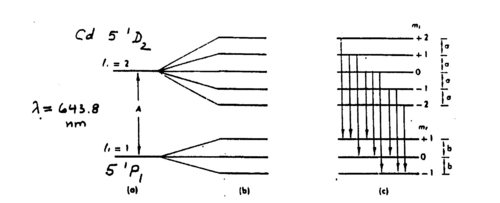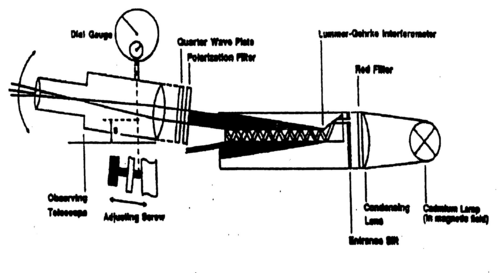Main Page/PHYS 4210/Zeeman Effect
Zeeman Effect
In this classic experiment that predates the development of quantum mechanics one investigates the light emitted by atoms in the presence of a homogeneous magnetic field. Of particular interest is the observation that this light is polarized in the presence of a magnetic field. The high-resolution spectroscopy required to resolve the line splittings is performed with a multiple-beam interferometer called a Lummer-Gehrcke plate which is similar to a Fabry-Perot interferometer.
Introduction
The Zeeman effect is a powerful demonstration of the splittings of magnetic sublevels in an angular momentum multiplet. Many aspects of the emission of light by excited atoms, particularly when exposed to strong magnetic fields (B) were understood by Lorentz in a classical model [1,2] before the advent of quantum mechanics. It is possible to understand the changes to classical electron orbits due to the Lorentz force in a 3D harmonic oscillator model. When one complements this with the idea that electromagnetic waves are transverse (the associated electric and magnetic fields of the EM wave oscillate in a plane perpendicular to the propagation direction of the wave), one can understand why circularly polarized light emerges as the atoms are observed in a direction longitudinal with the external B field, and why they appear as plane-polarized as viewed from the transverse direction. The understanding in the classical framework helps to build an intuition about the problem.
In the modern quantum mechanical description [2,5,6] one has to take into account that the presence of the B field singles out an axis. The additional interaction term between the magnetic moment of the electronic state (proportional to the z component of the total angular momentum) and B serves to split the magnetic sublevels of states with non-zero angular momentum. The additional interaction forces the use of this axis as a quantization axis. Without an external field one usually picks a z axis, but should arrive at results that are independent of this choice. To obtain the observed result that the light emanating from spontaneous transitions without an external field is unpolarized, one has to average over random orientations of the quantization axis. The observation that a definite orientation is singled out as quantization axis in the Zeeman effect is sometimes referred to as ‘space quantization’.
The problem can be illustrated by using pure orbital angular momentum states, i.e.,ignoring spin, and considering an np - ms transition. This transition is an allowed electric dipole transition, since a single unit of orbital angular momentum is changed, and this difference of one unit is carried away in the form of the spin for the spontaneously radiated photon. The important quantity to watch is the change in the projection of the orbital angular momentum, which can be +1, 0, -1 depending on the choice of the magnetic sublevel.
A transition 2p0 - 1s is associated with the emission of linearly polarized light with the oscillating electric field vector aligned with the z axis, with the wave propagation vector being orthogonal to this axis. This can be understood from the fact that the only non-vanishing matrix element for the dipole operator is <1s|z|2p0>. Similar calculations show that the transitions originating in the m = 1 and m = -1 sublevels result in circularly polarized light being emitted, which can propagate in the z direction only. One of the fascinating aspects of the Zeeman experiment is the following. For field-free atoms no axis is singled out, and thus, one has to include all possible orientations of the z axis, which results in the prediction that the light emitted from free atoms is unpolarized. However, once a homogeneous magnetic field is applied, an axis is singled out in space, which becomes the natural quantization axis. By probing the polarization of the spontaneously emitted light of atoms in the presence of a magnetic field one can verify that indeed the turn-on of the field causes a repopulation of the magnetic sublevels in a way that corresponds to the classical predictions of the Lorentz model. Thus, it is necessary to observe the light emitted longitudinally and transverse to the magnetic field.
The general theory of the Zeeman effect is complicated by the fact that the total angular momentum, i.e., added orbital and spin angular momentum of the active electron has to be considered. Based on orbital angular momentum alone the magnetic moment of an electron in a non-zero m sublevel is an integer multiple of the projection lz. Once one couples l and s to form j = l + s, the magnetic moment can be, but need not to be an integer multiple of jz, and the proportionality is given by the Lande factor g. The Lande factor can take on half-integer numbers for the initial and/or final states involved in the transition. One distinguishes between the normal and anomalous Zeeman effects depending on whether this complication arises or not. [3]. The anomalous effect is rather common in atomic transitions, but in this experiment a transition with the normal Zeeman effect has been selected. The red line in cadmium (643.8 nm), which is the equivalent of the yellow line in mercury, cf.. the Grotrian diagram shown in the appendix, and the level diagram in Fig. 1 (which is Fig. 7.3 from Melissinos [3]).
|
Figure 1 - Level diagram for the Cd 643.8 nm transition with and without B field.
|
From an experimental point of view a high demand is placed on the optical resolution of the interferometer. The idea is to inspect the interference pattern for a given line and to observe the quantitative changes in the pattern as the B field is applied to determine the wavelengths of the various components. The high resolution required can be obtained from multiple-beam interferometers, such as the Fabry-Perot (FP) interferometer [1,3]. Melissinos [3] discusses the analysis of the circular fringe pattern as produced by the FP. An easier alternative is provided by a special instrument that perfects the same method, called a Lummer-Gehrcke (LG) plate [1]. Since its interference pattern is more complicated to derive, you should concentrate on understanding the principles of multiple-beam interferometry using the FP and be aware of the analogies. Note that the FP has a wide range of applications in optics.
|
Figure 2a - Multiple reflection between the surfaces of a Lummer-Gehrcke plate.
|
|
Figure 2b - Apparatus for the Zeeman experiment with a Lummer-Gehrcke plate.
|
The LG plate shown as part of the apparatus in Fig. 2 consists of a precisely polished quartz glass plate of given thickness d with a prism attached at one end so that light entering from the slit has an angle of incidence on the plate that is near the critical angle. This results in some refractive transmission and mostly reflection at the glass/air surface. The reflected light inside the glass plate undergoes multiple ‘bounces’ of this type (interior reflection and partial refractive transmission). Two different interference patterns emerge when looking at a grazing angle at the top or bottom of the LG plate. The pattern formed at the top shows sharp bright lines on a dark background. In contrast to a Michelson interferometer a multiple-beam interferometer such as the FP and LG can produce an uneven interference pattern [1,3].
The separation between the fringes that appear without the magnetic field depends on the angle of observation. This spacing ΔA has to be determined for the particular fringe chosen for observation. As a magnetic field is applied each bright fringe splits either into two or into three depending on the orientation with respect to the magnetic field. To obtain a quantitative measure of the Zeeman effect, one needs to determine the B dependent splitting ΔS relative to ΔA. Making use of the ratio eliminates the need to know the optical magnification, observation angle and distance from the plate. The frequency splitting depends also on the LG plate thickness d (as in the FP case), and additionally on the index of refraction η of the quartz glass. In the FP case this would be equal to 1, but there are versions of the experiment where the evacuation of a sealed FP interferometer is used to produce a scanning effect in the fringe pattern [4]. The frequency splitting can be written as


